The Continuous Fryer Machine Market is estimated to be valued at USD 970.1 million in 2025 and is projected to reach USD 1610.6 million by 2035, registering a compound annual growth rate (CAGR) of 5.2% over the forecast period.
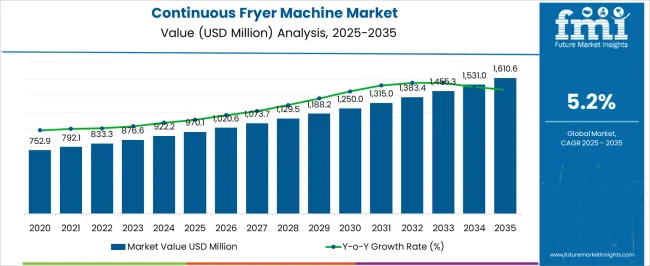
| Metric | Value |
|---|---|
| Continuous Fryer Machine Market Estimated Value in (2025 E) | USD 970.1 million |
| Continuous Fryer Machine Market Forecast Value in (2035 F) | USD 1610.6 million |
| Forecast CAGR (2025 to 2035) | 5.2% |
The continuous fryer machine market is progressing steadily, fueled by increasing demand for efficient and high-capacity frying solutions in the food processing industry. Growing consumer preference for fried food products combined with the need for consistent product quality and operational efficiency is driving adoption.
Technological advancements in frying equipment that enhance energy efficiency and reduce oil consumption are playing a crucial role in market expansion. Regulatory focus on food safety and hygiene standards is also influencing manufacturers to upgrade to continuous fryer machines that offer better control and automation.
The future outlook is promising as expanding food processing plants, especially in emerging economies, continue to seek scalable and cost-effective frying solutions. Collaborative innovation between equipment suppliers and food manufacturers is expected to further propel market growth, enabling customization and enhanced productivity.
The market is segmented by Product Type and Application and region. By Product Type, the market is divided into Gas, Steam, and Others. In terms of Application, the market is classified into Food Processing Plant, Restaurant, and Others. Regionally, the market is classified into North America, Latin America, Western Europe, Eastern Europe, Balkan & Baltic Countries, Russia & Belarus, Central Asia, East Asia, South Asia & Pacific, and the Middle East & Africa.
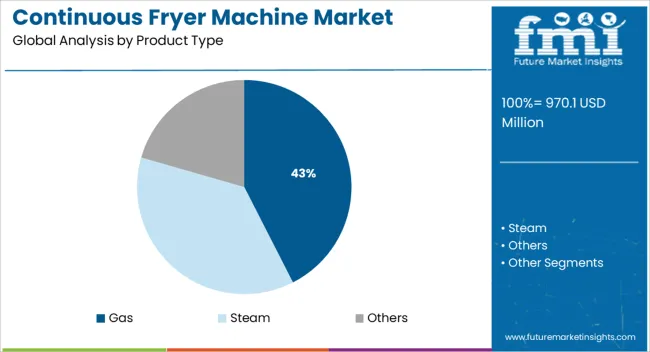
When segmented by product type, the gas segment is anticipated to hold 42.5% of the total market revenue in 2025, positioning it as the leading product type. Its dominance is attributed to advantages such as rapid heat transfer, cost effectiveness in fuel consumption, and compatibility with large-scale operations typical of food processing plants.
Operational reliability and ease of temperature control associated with gas-powered fryers have enhanced their adoption in continuous frying applications. Furthermore, the widespread availability of natural gas and propane in industrial settings supports the segment's growth.
The capacity to deliver consistent frying results with lower energy expenditure has made gas continuous fryers preferred equipment for high-volume food processors focused on maximizing throughput while managing operational costs.
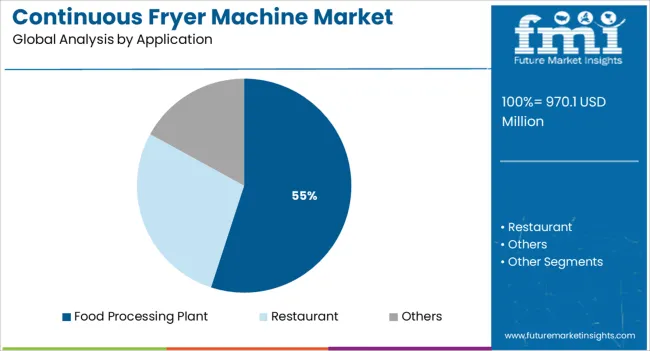
Segmented by application, food processing plants are projected to account for 55.0% of the total market revenue in 2025, securing their position as the top application segment. This leadership has been driven by the growing scale and automation of food manufacturing facilities which demand continuous frying solutions capable of maintaining product uniformity and efficiency.
The integration of continuous fryers into processing lines enhances productivity and reduces labor costs by automating frying operations. Food processors’ focus on quality control, regulatory compliance, and minimizing oil usage aligns with the benefits offered by continuous fryer machines.
Additionally, increased consumer demand for fried snacks and convenience foods has led to expansion of processing capacities, further driving the need for reliable, large-capacity frying equipment in these plants.
As per FMI, over the past five years, the global market for continuous fryer machines boosted at a fast pace owing to their rising application in various areas. They also have numerous benefits such as ease of processing and consumption of low energy.
The market for continuous fryer machines is projected to rise at a rapid pace in the forecast period due to the expansion of the global food processing industry. Automatic and semi-automatic continuous fryer machines are extensively used by this particular end user.
However, one of the most common problems that can occur with a continuous fryer is that the heating element can become damaged or broken. If this happens, it can cause the food to cook unevenly or even burn.
In some cases, it may also be necessary to replace the entire fryer. Another problem that can occur is that the oil may not be able to reach the correct temperature, which can also cause uneven cooking or burning.
A large number of crucial factors have been detected to accelerate the continuous fryer machine market. Lead analysts at FMI have evaluated the hindering factors, new opportunities, and threats that can affect growth in the global continuous fryer machine market.
The drivers, restraints, opportunities, and threats (DROTs) identified are as follows:
DRIVERS
RESTRAINTS
OPPORTUNITIES
THREATS
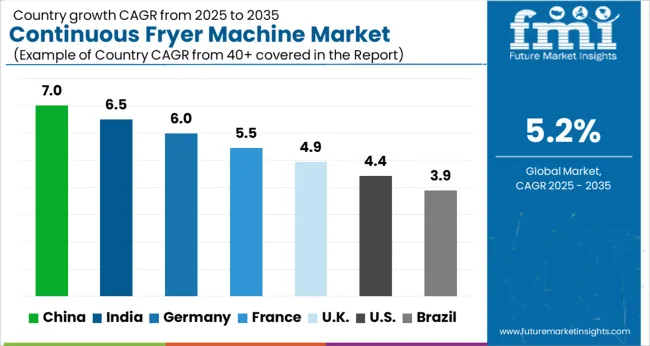
USA-based Companies to Launch Innovative Continuous Vacuum Fryers to Attract a Large Consumer Base
According to FMI, the demand for continuous fryer machines in the US is expected to rise at a CAGR of 38% throughout the forecast period. Since the last few years, the high demand for continuous fryer machines has been compelling US-based manufacturers to come up with new products.
A continuous fryer machine is a type of fryer that can be used to cook large quantities of food at a consistent temperature. This type of fryer is typically used in commercial kitchens, but they are also becoming more popular across the US for home use.
There are different brands and models of continuous fryer machines available in the US market. Thus, key companies are set to face tough competition from local firms across the country during the projected time frame.
Sales of Small Kitchen Appliances through Medium-size Companies to Grow Astonishingly across India by 2035
Due to the rapidly rising population and busy schedules of people, demand for continuous fryer machines has been increasing at regular intervals across India. Small continuous fryers are likely to showcase double-digit growth throughout the evaluation period.
This is further encouraging various medium and small-sized Indian companies to partake in the continuous fryer machine industry. International players are looking to establish their presence in the Indian continuous fryer machine market with the expansion of their distribution channels to improve access to the local market.
German Companies to Sell Their In-house Kitchen Appliances in Competitive Prices
Germany is considered to be one of the leading manufacturers of continuous fryer machines in Europe. Numerous German companies have been able to maintain their dominance in the market by investing heavily in research & development activities.
They have also been able to produce high-quality products at competitive prices. Some of the leading German companies have been successful in marketing their products to both retail and food service customers.
These companies have a strong distribution network throughout Europe. They also have a good reputation for customer service and after-sales service. Thus, their aggressive marketing efforts are expected to help Germany to continue to dominate the Europe continuous fryer machine market in the next ten years.
Demand for Air Fryer Machines to Grow Astonishingly across UK-based Fast Food Restaurants
Throughout the assessment period, the UK is expected to generate the lion’s share in the Europe market for continuous fryer machines. The country’s continuous fryer machine industry is set to be pushed by increasing demand for fryers in full-service restaurants, quick-service restaurants, hotels, and cafeterias. The rising establishment of renowned fast food chains like McDonald's, Pizza Express, Greggs, Harvester, and KFC across the country would also contribute to growth.
Sales of Electric Fryer Machines to Surge Rapidly with their Ability to Prevent the Risk of Fumes
There are many types of continuous fryer machines used in industries across the globe, including gas, steam, and others. Amongst these, the most common type of machine is the gas fryer. These fryers use natural gas or propane to heat the oil. The oil is first heated to a high temperature and then the food is placed in the basket. The food is cooked in hot oil and then drained before it is served.
Another type of continuous fryer machine that is gaining immense popularity nowadays is the electric fryer. These fryers use electricity to heat oil. One of the major advantages of these fryers is that they can be used indoors without the risk of any fumes or odors. Electric fryers are also more efficient than gas fryers, so they use less energy and are relatively low-cost in terms of operation.
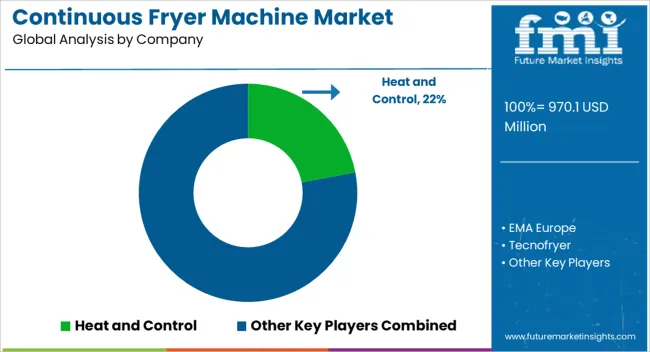
New entrants with innovative designs are expected to drive the use of continuous fryer machines in the food service industry across the globe. Renowned companies in the global market are coming up with electric fryers with unique features by conducting extensive research & development activities.
Some other companies around the world are striving to fulfill the unmet needs of their clients by providing customized solutions as per their requirements.
For instance,
| Attribute | Details |
|---|---|
| Estimated Market Size (2025) | USD 970.1 million |
| Projected Market Valuation (2035) | USD 1610.6 million |
| Value-based CAGR (2025 to 2035) | 5.2% |
| Forecast Period | 2025 to 2035 |
| Historical Data Available for | 2020 to 2025 |
| Market Analysis | Value (USD Million) |
| Key Regions Covered | North America; Latin America; Europe; Asia Pacific; Oceania; Middle East & Africa (MEA) |
| Key Countries Covered | The USA, Canada, Mexico, Germany, The UK, France, Italy, Spain, China, Japan, India, South Korea, Australia, Brazil, Argentina, South Africa, UAE |
| Key Segments Covered | Product, Type, Application, Region |
| Key Companies Profiled | Jinan Kelid Machinery; TSHS; Tianjin hitless machinery; QINGDOO tune Machinery; Jinan tindo International Co. Ltd.; PSG Dallas; Nilma; Schomaker Convenience Technik; Kalyan Machines; Ding Han Machinery; Zhengzhou Longer Machinery; Huaxing Machinery |
| Report Coverage | Market Forecast, Company Share Analysis, Competitive Landscape, DROT Analysis, Market Dynamics and Challenges, and Strategic Growth Initiatives |
The global continuous fryer machine market is estimated to be valued at USD 970.1 million in 2025.
The market size for the continuous fryer machine market is projected to reach USD 1,610.6 million by 2035.
The continuous fryer machine market is expected to grow at a 5.2% CAGR between 2025 and 2035.
The key product types in continuous fryer machine market are gas, steam and others.
In terms of application, food processing plant segment to command 55.0% share in the continuous fryer machine market in 2025.






Full Research Suite comprises of:
Market outlook & trends analysis
Interviews & case studies
Strategic recommendations
Vendor profiles & capabilities analysis
5-year forecasts
8 regions and 60+ country-level data splits
Market segment data splits
12 months of continuous data updates
DELIVERED AS:
PDF EXCEL ONLINE
Continuous Inkjet Inks Market Forecast and Outlook 2025 to 2035
Continuously Variable Transmission (CVT) Market Size and Share Forecast Outlook 2025 to 2035
Continuous Ambulatory Peritoneal Dialysis Bags Market Size and Share Forecast Outlook 2025 to 2035
Continuous Motion Cartoner Market Size and Share Forecast Outlook 2025 to 2035
Continuous Cardiac Monitoring Devices Market Size and Share Forecast Outlook 2025 to 2035
Continuous Ketone Monitoring Market Size and Share Forecast Outlook 2025 to 2035
Continuous Flow Bioreactors Market Analysis - Size, Share, and Forecast Outlook 2025 to 2035
Continuous Inkjet Printers Market Size and Share Forecast Outlook 2025 to 2035
Continuous Friction Tester Market Size and Share Forecast Outlook 2025 to 2035
Continuous Glucose Monitoring Device Market - Demand & Future Trends 2025 to 2035
Continuous Hormone Monitoring Market Analysis - Size, Share, and Forecast Outlook 2025 to 2035
Continuous Emission Monitoring System Market Growth - Trends & Forecast 2025 to 2035
Continuous Positive Airway Pressure (CPAP) Market Analysis – Size, Share & Forecast Outlook 2025 to 2035
Continuous Glucose Monitoring Systems Market is segmented by transmitters and monitors, sensors and insulin pump from 2025 to 2035
Continuous Miners Market Growth - Trends & Forecast 2025 to 2035
Continuous Renal Replacement Therapy Market Growth – Trends & Forecast 2025-2035
Continuous Peripheral Nerve Block Catheter Market Growth – Trends & Forecast 2025-2035
Market Share Breakdown of Continuous Inkjet Printers Providers
Continuous Thread Metal Cap Market
Continuous Integration Tools Market

Thank you!
You will receive an email from our Business Development Manager. Please be sure to check your SPAM/JUNK folder too.
Chat With
MaRIA